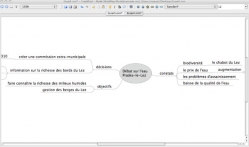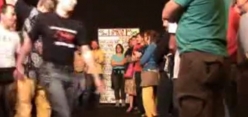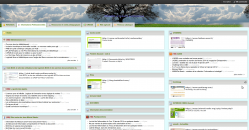Which map for which collective intelligence ?
To enable the development of collective intelligence in the writing of a collective document or in the solving of conflicts for instance, maps can be used to show the different progressions of members and discover some new ones. The use of mind maps (
mind mapping) is particularly powerful. During face-to-face meetings, maps can be cast on a wall so that everyone has an overview. Thus it changes completely the way people propose new ideas rather than repeating those they remember... generally theirs.
But there are limits to this approach : mind map soon becomes complex. Someone who arrives along the way will find it difficult to understand. Those who were there from the start can use it rather effectively... until the projector is switched off. The amount of ideas on the map often exceed our working memory's limits and soon after the work session we stop thinking and remember only a few conclusions that poorly illustrate the richness of the discussion. We have successfully tested the superimposition of a mind map on a territory according to the «method of Loci» method. The metaverse francophone library has created a virtual island
20 hosting the different concepts of our book Prospectic
21 on emerging sciences and technologies (Nanotechnologies, Biotechnologies, Complex systems theory, IT, Neurosciences, Cognition...). Besides, in the framework of a 6-sessions public debate on synthesic biology set up by Vivagora, we have mapped real time ideas and opinions about an imaginary city
22.
This method using mind maps proved to be particularly powerful during face-to-face sessions or else during online meetings (synchronous meetings). It's different with asynchronous online meetings, when each member reacts in the debate when he chooses to. Indeed, in this case, the level of member's attention fluctuates from pro-activity to episodic observation
23. Co-mapping step-by-step with everyone's attention becomes difficult. Besides, it's hard to find spots known by all and which can we can use as bases to locate one or two hundreds concepts. Our houses and our environment are well memorized and they can be a media for the method of Loci. But they are different for each member and can only be used individually. The world map could possibly be used as a base because we have all already memorized a part of it, but it's tricky to locate ideas-most of the time subjective- on inhabited countries or territories. For example where would be located the notion of deviance? The best applicant seems to be the human body where even a uneducated person can locate dozens of different spots. Vivian Labrie has experimented this approach with human sculptures composed of several members during debates about poverty in Quebec
24. Besides, during an online debate, reactive participants which are ten times more numerous than proactive ones, get information and summaries through a tool rather geared to text (mail, Facebook, Twitter)
25 which they read regularly and don't really make the effort to look at a graphical mind map on a specific web page. Asking to click on a link in a sent text will reduce by half the number of potentially reactive persons.
Therefore during online debates, it is more interesting to have a mind map exclusively built with (even if with Twitter there is still the need to click on link to propose more than 144 characters). When formatted, the text enables that kind of possibilities with item-structured lists (which make an arborescence as mind maps) and different artifacts allowing to browse a text just like a map, reading an exhaustive reading needless (bold, underlined...). By keeping short the "textual mind map", the size of an average computer screen, we enable participants to have an overview of exchanges and to use Thinking-2 to produce collective intelligence.
- 1 Thes ideas are originally presented in : CORNU, Jean-Michel. Modes de pensée et conflit d’intérêt. In : Nouvelles technologies, nouvelles pensées ? [online]. Limoges, France : FYP éditions, 2008. Innovation, ISSN 1961-8328. ISBN 978-2-916571-03-4. Available from : http://www.cornu.eu.org/files//ProspecTIC_pensee2.pdf
Available from article : Nous avons non pas un mais deux modes de pensée. Le blog de Jean-Michel Cornu [online]. [Accessed 4 February 2014]. Available from:
http://www.cornu.eu.org/news/nous-avons-non-pas-un-mais-deux-modes-de-pensee
- 2 The rational reasoning process is to put forward an hypothesis and then to try to refute it. Since Aristotle we actually know that it is not possible to demonstrate that a global theory - Aristotle talks of " universal proposal" -is true (a sentence like all rabbits have a tail cannot be completely checked because how can we be sure we have seen all the rabbits...). The rational reasoning process is then to demonstrate that the theory is wrong. If it can't be done, the theory is considered sufficiently good to be provisionally true... until a refutation invalidates it. The scientific reasoning process is based on the rational reasoning process but it attempt tempting to draw checkable forecasts from the theory which allow a refutation... or not.
- 3 Antagonisme. Wikipédia [online]. [Accessed 4 February 2014]. Available from : http://fr.wikipedia.org/wiki/Antagonisme
- 4 See How to produce a text when you are several hundred persons - La parabole des aveugles et de l'éléphant
- 5 get to know more, see the square of opposition : Le carré Sémiotique. Le blog de Jean-Michel Cornu [online]. [Accessed 4 February 2014]. Available from : http://www.cornu.eu.org/news/le-carre-semiotique
- 6 Voir The post factum choice
- 7 It is because of the use of spoken or written language which unrolls sequentially. Other forms of language could allow to translate simultaneously two or more notions. Like in dance for instance. Bees use that form of language (yet without having an elaborated symbolic language as ours). As well as the language of signs for deaf and hearing-impaired enables things which are not possible with spoken language, for example telling one thing with the left hand and something else even contrary with the right one !
- 8 MONOD, Jacques. Le hasard et la nécessité: essai sur la philosophie naturelle de la biologie moderne. Paris, France : Éd. du Seuil, 1970. Points. Série Essais, ISSN 1264-5524, 43. ISBN 978-2-02-000618-7.
- 9 BADDELEY, Alan D. and HITCH, G. J. Working memory. In : BOWER, G. H. (ed.), The psychology of learning and motivation : Advances in research and theory Volume 8. New York : Academic Press, 1974. p. 47–90. ISBN 9780080863597 0080863590 0125433085 9780125433082.
- 10 DE BONO, Edward. Conflits: comment les résoudre. Paris, France : Eyrolles, 2007. ISBN 978-2-212-53952-3.
- 11 BADDELEY, Alan D. and HITCH, G. J.ibid.
- 12 Called "semantic memory"
- 13 MILLER, George A. The magical number seven, plus or minus two: some limits on our capacity for processing information. Psychological review [online]. 1956. Vol. 63, no. 2, p. 81. [Accessed 4 February 2014]. Available from : http://psycnet.apa.org/journals/rev63/2/81/
- 14 CORNU, Jean-Michel. Nouvelles technologies, nouvelles pensées ? Limoges, France : FYP éditions, 2008. Innovation (Limoges), ISSN 1961-8328. ISBN 978-2-916571-03-4.
- 15 YATES, Frances Amelia. L’art de la mémoire. Paris, France : Gallimard, 1987. Bibliothèque des histoires, ISSN 0768-0724. ISBN 2-07-070982-5, 978-2-07-070982-3.
- 16 CICÉRON. De l’orateur. Paris, France : Les Belles Lettres, 1966. Collection des universités de France, ISSN 0184-7155.
- 17 CARRUTHERS, Mary J. Machina memorialis : méditation, rhétorique et fabrication des images au Moyen Age. Paris, France : Gallimard, 2002. Bibliothèque des histoires, ISSN 0768-0724. ISBN 2-07-075746-3.
- 18 CARRUTHERS, Mary J.ibid.
- 19 Des cartes pour décrire des contes : rencontre avec Vivian Labrie. Le blog de Jean-Michel Cornu [online]. [Accessed 4 February 2014]. Available from : http://www.cornu.eu.org/news/des-cartes-pour-decrire-des-contes
- 20 ile Prospectic. ProspecTIC [online]. [Accessed 4 February 2014]. Available from : http://prospectic.fing.org/texts/ile-prospectic
- 21 CORNU, Jean-Michel. Nouvelles technologies, nouvelles pensées ? Limoges, France : FYP éditions, 2008. Innovation (Limoges), ISSN 1961-8328. ISBN 978-2-916571-03-4.
- 22 Biosynth-ville : la ville de la biologie synthétique. Vivagora [online]. [Accessed 4 February 2014]. Available from : http://web.archive.org/web/20130619184123/http://www.vivagora.fr/index.php?option=com_content&view=article&id=436:biosynth-ville-la-ville-d-ela-biologie-synthetique&catid=21:nos-actions&Itemid=111
- 23 Voir Size of groups and parts of members
- 24 Collectif pour un Québec sans pauvreté. [online]. [Accessed 4 February 2014]. Available from : http://www.pauvrete.qc.ca/
- 25 Voir Size of groups and parts of members
To sum up
In a debate with several people, and even more in a confrontation, each one tends to defend his idea and to repeat it constantly so it is taken into account. In practice it's often seen that different points of view don 't rule each other out but on the contrary complement each other to give altogether an overview. To go past the facts, me must take into account the two ways of thinking that are each using a different working memory.
The first, based on speech consist in sayings ideas one after the other, just as we make a step after another to progress from a starting point until an arrival. This way of thinking especially allows a rational approach but it hardly takes into account conflict (a starting point, two directions), collective intelligence (several points of view on the same arrival) or else creativity (finding new ways between several starting points and several arrivals) which are all three using another complementary way.
The second way of thinking is based on mapping. It consists in arranging on the same mind map ideas according to their proximity, without trying to select them offhand, to get the more complete vision on ideas and possible progressions. Mind maps (mind mapping in English) which are co-built and projected to all during sessions are very efficient to give a global vision to the whole group and allow therefore to look for new ideas and new points of view rather than having each member focusing on one or two former ideas.
To go further, two possible approaches :
- the Method of Loci : During synchronous meetings (online or face-to-face), a map of idea can be coupled with another map, often of territories that each one can keep in his long term memory. It can be a place known to all (their cathedral for monks in the Middle Ages)or failing that a co-built place (in the long term a place is easier to remember than ideas) ;
- Textual maps : in asynchronous online exchanges, people who behave reactively (ten times more numerous than proactive) and the observers (even more numerous) use tools which cannot stand graphics mode very well (mail, Facebook, Twitter). Therefore proposing a drawn map needs to share a link to a web page where the map is hosted. But then only a half of participants will see the map. The possible use of text laying out can then be used to allow the drawing of a textual map which won't need to be read in its whole as a text but can be read as a map : lists of bullet points, formulation of short ideas in one line maximum, bold, underlined and italics to enhance some keywords.
Mot clé : #cartographier
Copyrights : By วาดโดยบุญศิริ เทพภูธร สพอ. นครหลวง จ.พระนครศรีอยุธยา [Public domain], via Wikimedia Commons




